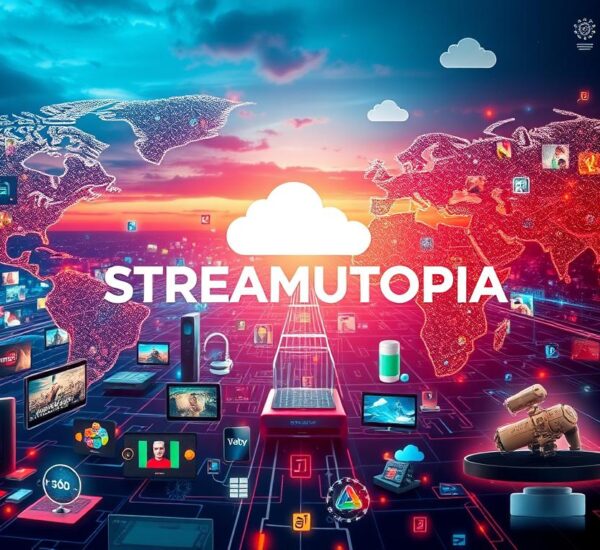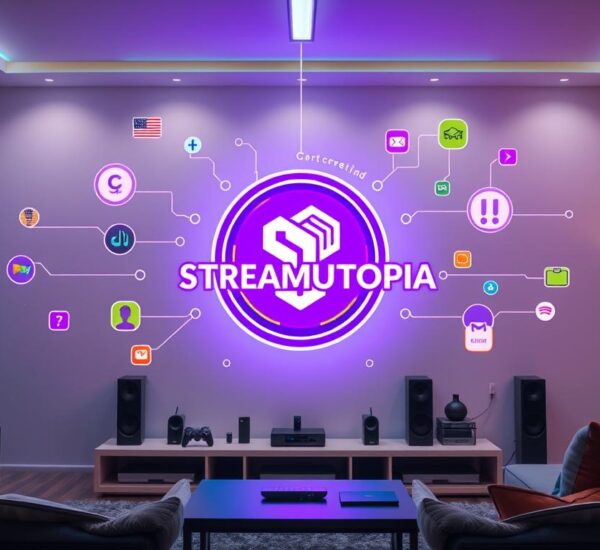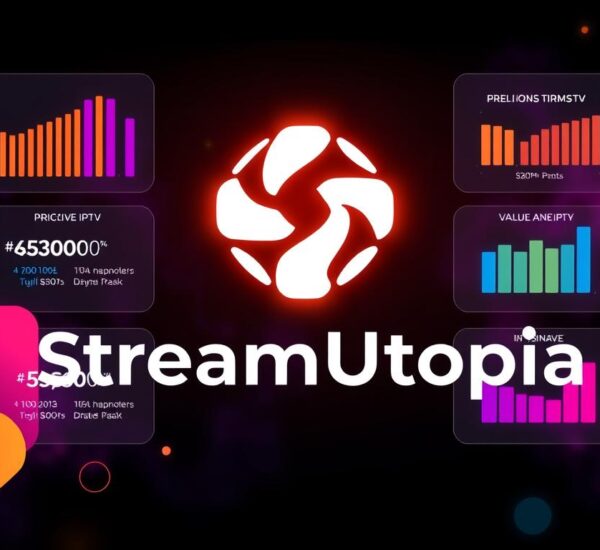Did you know that IPTV platforms are facing increasing scrutiny for their content censorship practices?
Over the past decade, the rise of OTT platforms like Netflix, Amazon Prime Video, and Disney+ has brought about significant changes in the entertainment industry. While this newfound freedom of choice and convenience is empowering, concerns have arisen regarding morally objectionable material. This article explores the ethical implications of IPTV content censorship and how it affects viewership freedom and expression.
Key Takeaways:
- The ethical considerations of IPTV content censorship are crucial in maintaining a balance between artistic liberty and social responsibility.
- Content censorship on OTT platforms plays a vital role in safeguarding vulnerable audiences from morally objectionable material.
- Censorship helps guide early teens towards responsible behaviors by limiting their exposure to drugs, violence, and abusive behavior.
- Implementing content censorship helps uphold moral and social standards in the entertainment industry.
- Censorship on OTT platforms contributes to mitigating the spread of disinformation and misleading content.
Safeguarding Vulnerable Audiences
OTT platforms have a wide-ranging audience, including children and teenagers who are particularly susceptible to the influence of media. Implementing content censorship can shield these vulnerable groups from exposure to morally objectionable material that can potentially lead to harmful actions or misguided behavior.
Children and teenagers are in a critical stage of development, and the media they consume significantly shapes their beliefs, attitudes, and behaviors. The availability of content that contains explicit violence, sexual content, or other morally objectionable material can pose a risk to their well-being and development.
Censorship on OTT platforms plays a crucial role in protecting vulnerable audiences from harmful content. By proactively filtering and moderating the material that is accessible to them, these platforms can ensure a safer and more responsible viewing experience.
Shielding Children from Harmful Content
Children are easily influenced by what they see, making it essential to protect them from exposure to content that may depict or promote harmful behavior. Content censorship helps create a barrier between vulnerable audiences and material that may have a detrimental impact on their emotional, psychological, and social well-being.
Censoring morally objectionable material ensures that children are not exposed to content that normalizes violence, substance abuse, or other harmful actions. By limiting their access to such content, OTT platforms help shape a healthier and more positive media environment for them.
Guiding Teenagers towards Responsible Viewing
Teenagers are at a stage of exploration and experimentation, seeking independence and identity. While they may be more critical and discerning viewers, they can still be influenced by the media they consume. Censoring morally objectionable content helps guide them towards responsible viewing choices, promoting positive values and behaviors.
By restricting access to content that portrays harmful behavior or misguided actions, OTT platforms can encourage teenagers to develop a more balanced perspective, promoting empathy, respect, and critical thinking. This proactive approach safeguards their well-being and contributes to their personal growth.
| Benefits of Content Censorship for Vulnerable Audiences |
|---|
| Protects vulnerable children and teenagers from exposure to harmful content |
| Promotes a safe and responsible media environment |
| Guides teenagers towards responsible viewing choices |
| Fosters positive values and behaviors |
Addressing the Impact on Early Teens
Early teens, with their curiosity and rebellious nature, are highly impressionable viewers who are easily influenced by the media they consume. At this stage of development, they are more prone to exploring and imitating what they see, making it crucial to guide them towards responsible behaviors.
Content that portrays drug use, violence, and abusive behavior can have a detrimental effect on early teens, shaping their perception of these actions as acceptable or even glamorous. By censoring such content on IPTV platforms, we can protect these young viewers and redirect their attention towards more positive and responsible behaviors.
Empowering Responsible Decision-Making
As early teens navigate through the complex world of media and entertainment, it is essential to provide them with age-appropriate content that promotes responsible behavior and decision-making. By removing explicit displays of drug use, violence, and abusive behavior, IPTV platforms can contribute to the development of impressionable viewers, encouraging them to make sound choices.
Setting a Positive Example
By censoring harmful content, IPTV platforms send a powerful message about the values and behaviors they endorse. Taking a stand against drug use, violence, and abusive behavior demonstrates a commitment to creating a safe and enriching environment for early teens. This responsible approach helps establish a foundation of positive values, which can influence their behavior in real-life situations as well.
Supporting Emotional Well-being
Exposure to explicit content at a young age can have lasting effects on the emotional well-being of early teens. By censoring materials that include drug use, violence, and abusive behavior, IPTV platforms prioritize the mental health and emotional development of these impressionable viewers. Promoting responsible behaviors and positive role models can contribute to a healthier and more balanced adolescence.
Fostering Meaningful Conversations
Content censorship acts as a catalyst for important discussions and conversations between early teens and their parents or guardians. By addressing the impact of drug use, violence, and abusive behavior in the media, families can engage in dialogue surrounding responsible behaviors and help shape their child’s understanding of right and wrong. This proactive approach encourages critical thinking and empathy.
Upholding Moral and Social Standards
OTT platforms have a responsibility to uphold moral and social standards within their content. Broadcasting material that includes explicit drug use, violence, and abusive language can erode societal norms and values. In order to prevent the desensitization of audiences towards harmful behaviors, implementing content censorship is crucial.
By censoring content that goes against these moral and social standards, platforms can ensure that viewers are not exposed to content that promotes explicit drug use, violence, or abusive language. This allows for a safer and more responsible viewing experience.
Through content censorship, OTT platforms can play a vital role in maintaining the ethical fabric of society. By curating content that aligns with societal norms and values, these platforms can help create a culture of respect and accountability.
Let’s take a look at the impact of content censorship on moral and social standards:
| Moral and Social Standards | Benefits of Content Censorship |
|---|---|
| Preserving societal norms and values | Protecting viewers from explicit content |
| Promoting responsible behavior | Upholding community standards |
| Preventing the normalization of harmful behaviors | Creating a safer viewing environment |
Content censorship ensures that these platforms are not contributing to the erosion of moral and social standards. By setting an example for responsible content creation and consumption, OTT platforms can help foster a society that values respect, empathy, and responsible behavior.

Mitigating Disinformation and Misleading Content
In the digital age, the proliferation of misinformation and fake news has become a major concern. It is crucial for OTT platforms to play a role in combatting the spread of disinformation and misleading content. Content censorship is one effective measure that platforms can take to ensure that viewers have access to reliable information and entertainment.
By enforcing content censorship, OTT platforms can establish guidelines to verify the accuracy and authenticity of the content being showcased. This helps to foster an environment where viewers can trust the information they consume and rely on the platform for reliable and trustworthy content. It is essential to create a space where viewers can navigate through the sea of information and find content that is not only entertaining but also factual and reliable.
One way to combat disinformation is by promoting fact-checking and verification processes. This can involve partnerships with reputable fact-checking organizations or the implementation of in-house fact-checking teams. By verifying the information presented in the content, platforms can ensure that viewers are not misled by false claims or distorted narratives.
In addition to fact-checking, platforms can also invest in machine learning algorithms and artificial intelligence tools that can detect and flag potentially misleading or false information. These technologies can analyze the content for inconsistencies, biases, and anomalies that may indicate the presence of disinformation.
Example: Guidelines for Content Verification
| Guidelines for Content Verification: | Actions |
|---|---|
| 1. Fact-checking partnerships: | Collaborate with reputable fact-checking organizations to verify the accuracy of content. |
| 2. Internal fact-checking teams: | Establish in-house fact-checking teams to validate information presented in the content. |
| 3. AI-powered content analysis: | Utilize machine learning algorithms and AI tools to analyze and flag potentially misleading information. |
| 4. User reporting: | Encourage users to report disinformation or misleading content for review and action. |
By implementing these measures, OTT platforms can take proactive steps to mitigate the spread of disinformation and misleading content. This not only ensures that viewers have access to reliable information, but also helps to maintain the integrity and trustworthiness of the platform itself.
Collaboration with Regulatory Bodies
OTT platforms can ensure acceptable content standards by closely collaborating with regulatory bodies. This partnership helps address concerns regarding explicit drug use, violence, and abusive language, allowing for a safer viewing experience. Censorship measures can be implemented through content rating systems, parental controls, and age restrictions, empowering viewers to make informed decisions about the content they consume.
The Role of Regulatory Bodies
Regulatory bodies play a crucial role in establishing guidelines and standards for OTT platforms to ensure responsible content dissemination. These bodies, such as the Federal Communications Commission (FCC) in the United States or Ofcom in the United Kingdom, monitor and regulate content to safeguard viewer interests and protect against harmful material.
Content Rating Systems
Content rating systems are an effective way to classify content based on its suitability for different age groups. By implementing such systems, OTT platforms can provide clear and standardized information to help viewers make informed decisions about the content they wish to access. These ratings often include labels such as “PG-13” or “18+” to indicate the level of parental guidance or age restrictions.
Parental Controls and Age Restrictions
OTT platforms can empower parents and guardians to regulate content access for younger viewers through parental control features. These features enable the customization of viewing restrictions based on age, preventing children from accessing inappropriate content. By setting age restrictions, platforms can ensure that content that is suitable for mature audiences remains inaccessible to underage viewers.
Advantages of Informed Decisions
By providing viewers with the necessary information and tools, collaboration with regulatory bodies enables them to make informed decisions about the content they consume. This promotes a sense of control and responsibility, allowing individuals to filter content according to their personal preferences and values.
| Advantages of Collaboration with Regulatory Bodies | Examples |
|---|---|
| Enhanced viewer protection | Preventing exposure to explicit drug use, violence, and abusive language |
| Empowerment of parents and guardians | Enabling them to set appropriate content restrictions for children |
| Promotion of age-appropriate content | Ensuring that content aligns with the maturity levels of different audiences |
| Facilitation of responsible media consumption | Encouraging viewers to engage with content that aligns with their values |
Encouraging Responsible Artistic Expression
Content censorship on OTT platforms plays a crucial role in promoting responsible artistic expression. By establishing ethical boundaries, platforms ensure that artists and creators have the freedom to convey their messages while respecting societal values and norms. This fosters a diverse range of content that reflects the creativity and imagination of artists while upholding ethical standards.
Responsible artistic expression on OTT platforms encourages creators to push the boundaries of creativity while taking into account the impact their content may have on viewers. It allows for the exploration of various themes, narratives, and artistic styles while being mindful of the potential influence on vulnerable audiences.
Artists have the power to captivate and inspire, and with this power comes a responsibility to consider the societal implications of their work. Content censorship helps artists navigate the ethical challenges that arise when dealing with sensitive subjects or controversial themes.
By encouraging responsible artistic expression, content censorship fosters a safe and enriching entertainment experience for viewers. It ensures that the content showcased on OTT platforms aligns with the values and expectations of the audience, while still allowing for innovation and creative freedom.
Through a balanced approach to content censorship, platforms strike a chord between artistic liberty and social responsibility. By implementing guidelines and standards, they foster an environment where creators can thrive within ethical boundaries while producing thought-provoking and engaging content.
Ultimately, responsible artistic expression on OTT platforms serves as an avenue for artists to connect with their audiences while respecting the diverse perspectives and societal values. It allows for the exploration of complex topics, encouraging dialogues and conversations that contribute to a more informed and empathetic society.
Impact of Content Censorship on Artistic Freedom
While content censorship is necessary to maintain ethical boundaries, it also raises questions about artistic freedom. Some argue that censorship may stifle the freedom of expression and limit the ability of artists to fully explore their creative visions.
However, it is important to establish a balance between artistic freedom and societal responsibility. Responsible artistic expression can coexist with content censorship, as creators have the opportunity to express their ideas within ethical boundaries. This approach ensures that OTT platforms provide an inclusive and culturally sensitive environment for both artists and viewers.
| Impact of Responsible Artistic Expression | Benefits of Content Censorship |
|---|---|
| 1. Allows artists to convey powerful messages | 1. Shields vulnerable audiences from harmful content |
| 2. Fosters creativity and innovation | 2. Upholds societal values and norms |
| 3. Encourages dialogue and critical thinking | 3. Promotes a diverse range of content |
| 4. Reflects the complexity of human experiences | 4. Mitigates the spread of disinformation |
| 5. Engages and entertains diverse audiences | 5. Protects the reputation of OTT platforms |
Laws and Regulations on OTT Platforms in India
OTT platforms, also known as over-the-top platforms, have experienced a significant surge in popularity in India. In 2019 alone, the market for OTT platforms in India was valued at approximately ₹35 billion. These platforms, such as Netflix, Amazon Prime Video, and Disney+, deliver audio and video streaming services directly to viewers via the internet, allowing them to access a wide range of content at their convenience. However, despite their growing prominence, there are currently no specific laws in place to regulate these platforms in India.
The absence of dedicated regulations has raised concerns about the presence of unethical and inadequate content on OTT platforms. The unrestricted nature of these platforms has led to debates regarding the need for appropriate laws and regulations to ensure the responsible and ethical distribution of content. Recent discussions have focused on striking a balance that preserves artistic freedom and expression while also safeguarding the interests of viewers.
As the popularity of OTT platforms continues to expand and paid subscriptions become increasingly prevalent, the need for comprehensive laws and regulations is becoming more apparent. Such regulations would establish a framework that governs content availability, ratings, and the implementation of parental controls. These measures aim to protect viewers from potentially harmful material and ensure age-appropriate content consumption.
By introducing laws and regulations on OTT platforms, authorities would have the means to address concerns related to ethical standards, content classification, and the prevention of objectionable material. Considerations for protecting vulnerable audiences, maintaining cultural sensitivities, and adhering to societal norms and values would be at the forefront. Measures such as content ratings, classifications, and clear guidelines could be established to enable viewers to make informed decisions about the content they choose to consume.
Implications of Regulating OTT Platforms
Regulating OTT platforms in India would have both advantages and challenges. On one hand, regulations would provide a structured environment where viewers can confidently engage with a diverse range of content without concerns about objectionable material. By establishing clear guidelines, platforms can maintain their integrity and ensure public trust by actively contributing to the ethical development of the entertainment industry.
Conversely, the introduction of regulations may impose limitations on artistic freedom and creative expression. Striking a balance between ensuring content adheres to moral standards while allowing artists to explore various themes without unnecessary restrictions is essential. The compatibility of regulatory measures with the open nature of the internet and the principles of net neutrality must also be considered to prevent unintended consequences.
The Need for Content Regulation in India
The need for content regulation on OTT platforms in India has become increasingly apparent due to mounting concerns about unethical content that promotes religious disrespect, engages children in criminal activities, and potentially promotes terrorism. Advocates argue that strict regulation is necessary to protect the public interest and ensure content meets ethical standards.
Unethical content that includes religious disrespect has the potential to incite social unrest and discord among different religious communities. By implementing content regulation, OTT platforms can prevent the dissemination of harmful and offensive material, fostering a more harmonious and tolerant society.
Another significant concern is the portrayal of criminal activities in content accessible to children. Exposure to such content can have detrimental effects on impressionable young minds, potentially normalizing illegal actions and influencing them negatively. Content regulation aims to shield children from harmful influences and ensure their well-being and development.
Furthermore, the potential promotion of terrorism through online platforms is a critical issue that content regulation seeks to address. By monitoring and restricting the dissemination of extremist content, authorities can prevent the radicalization of individuals and protect national security.
Advocates of content regulation maintain that it is essential to uphold ethical standards in the entertainment industry. By setting clear guidelines and enforcing content moderation, platforms can avoid inadvertently glorifying criminal activities, inciting religious hatred, or promoting ideologies that undermine societal peace and stability.
The public interest lies at the core of the need for content regulation. Ensuring the availability of safe and responsible content safeguards the well-being and values of individuals and communities. By striking a balance between artistic freedom and social responsibility, content regulation helps create an environment that respects diverse perspectives while upholding principles that promote the public good.
In the context of India’s multi-faith and culturally diverse society, the implementation of content regulation on OTT platforms emerges as a crucial step to protect the nation’s fabric, foster unity, and promote ethical entertainment options.
Illustrative Example:
A recent case highlighting the need for content regulation in India involved a popular web series that faced allegations of disrespectful depiction of religious figures. The content stirred widespread outrage among religious communities, leading to protests and public debates. This incident underscored the necessity of establishing robust content regulation measures to prevent the creation and dissemination of unethical content that can potentially disrupt social harmony.
Challenges and Limitations of Censorship
While censorship on OTT platforms can address concerns, it also poses challenges and limitations. Critics argue that censorship can restrict artistic freedom and fail to fully control illegal content. Instead, some suggest the implementation of content certification to differentiate suitable content for different age groups.
Artistic Freedom and Restrictions on Content
One of the main criticisms leveled against censorship on OTT platforms is its potential to limit artistic freedom. Artists and creators may feel restricted in their ability to express their ideas and creativity without fear of censorship. This restriction can hinder the exploration of unconventional or thought-provoking content, ultimately impacting the diversity and richness of the entertainment industry.
However, proponents of censorship argue that certain restrictions on content are necessary to ensure the responsible portrayal of sensitive subjects such as violence, explicit drug use, or abusive language. By implementing guidelines and standards, platforms can strike a balance between artistic freedom and the need to protect vulnerable audiences from harmful content.
The Challenge of Controlling Illegal Content
Censorship on OTT platforms also faces challenges in effectively controlling illegal content. Despite efforts to monitor and regulate content, some illegal or inappropriate material may still slip through the cracks. This poses a significant concern, especially when it comes to protecting viewers from content that promotes criminal activities, hate speech, or illicit behavior.
The Role of Content Certification
As an alternative to strict censorship measures, some suggest the implementation of content certification systems. These systems would involve categorizing and labeling content based on suitable age groups, similar to movie ratings. By providing clear information about the content’s suitability for different audiences, users can make informed decisions about the content they consume.
Content certification can enhance transparency and empower viewers to choose content aligned with their preferences and values. It also helps platforms maintain their public image by demonstrating a commitment to responsible content dissemination.

| Challenges of Censorship | Limitations of Censorship |
|---|---|
| Restriction on artistic freedom | Difficulty controlling illegal content |
| Potential impact on creative diversity | Need for more effective monitoring and regulation |
| Debate over responsible portrayal of sensitive subjects | Challenges in enforcing compliance with content guidelines |
Impact of Censorship on Freedom of Speech
Censorship on over-the-top (OTT) platforms has sparked debates surrounding its implications for freedom of speech and civil liberties. As the internet has become a vital platform for communication and expression, concerns arise about how content censorship can potentially restrict these fundamental rights.
One of the main concerns is the potential impact on the open nature of the internet. Net neutrality, the principle that all internet traffic should be treated equally, raises questions about whether restricting access to certain content and favoring specific platforms undermines this principle. By allowing censorship to determine what content users can access, there is a risk of limiting the free market of ideas, as well as the diversity and plurality of voices that contribute to an open and thriving digital space.
Freedom of speech and civil liberties are integral to a democratic society. Critics argue that content censorship can stifle dissenting opinions and limit the ability of individuals to express themselves freely. By imposing restrictions on what can be said or seen, censorship runs the risk of creating an environment where self-censorship becomes the norm, inhibiting open dialogue and the exchange of ideas.
Freedom of Speech and the Global Landscape
The impact of censorship on freedom of speech is not limited to any one country or region. Across the world, governments and organizations grapple with striking a balance between regulating content for the greater good and safeguarding individual rights.
Net neutrality, in particular, remains a key battleground in many jurisdictions. As governments and regulatory bodies consider implementing policies that allow for content censorship, it becomes essential to weigh the potential consequences for civil liberties and the open nature of the internet.
In countries where freedom of speech is enshrined in constitutional or legal frameworks, striking the right balance becomes even more critical. While governments may have legitimate concerns about protecting citizens from harm, it is essential to ensure that content censorship does not infringe upon the rights of individuals to express themselves freely.
In navigating the complexities of content censorship, it is crucial to assess the potential impact on freedom of speech and civil liberties. Striking a balance between regulating content for societal well-being and preserving the open nature of the internet remains a significant challenge in the digital age.
Image: Demonstrating the importance of freedom of speech in a democratic society
Conclusion
Content censorship on OTT platforms plays a vital role in striking a balance between artistic liberty and social responsibility. It serves as a necessary measure to protect vulnerable audiences, uphold moral and social standards, and mitigate the spread of disinformation. By implementing content censorship, viewership freedom is not compromised but rather enhanced by providing a safe and enriching entertainment experience.
Considering the ethical implications of IPTV content censorship is crucial in promoting a society that values expression while ensuring the well-being of its members. Through responsible content regulation, OTT platforms can guide impressionable viewers, such as early teens, towards making responsible choices and foster a positive influence on their development.
It is incumbent upon OTT platforms to collaborate with regulatory bodies and establish content guidelines and rating systems. By doing so, platforms enable viewers to make informed decisions about the content they consume, promote responsible artistic expression, and align with societal norms and values. This collaboration also helps address concerns regarding explicit drug use, violence, and abusive language, which can erode ethical boundaries.
In the ever-evolving landscape of the entertainment industry, content censorship on OTT platforms is a critical tool for maintaining viewership freedom and expression. By addressing the ethical implications of IPTV content censorship, platforms can navigate the delicate balance between artistic liberty and social responsibility, ensuring a safe and inclusive environment for all.
FAQ
What are the ethical implications of IPTV content censorship?
How does content censorship safeguard vulnerable audiences?
How does content censorship address the impact on early teens?
How does content censorship uphold moral and social standards?
How does content censorship mitigate disinformation and misleading content?
How do IPTV platforms collaborate with regulatory bodies?
How does content censorship encourage responsible artistic expression?
What are the laws and regulations on OTT platforms in India?
Why is there a need for content regulation in India?
What are the challenges and limitations of censorship?
How does censorship impact freedom of speech?
What is the conclusion regarding IPTV content censorship ethics?





